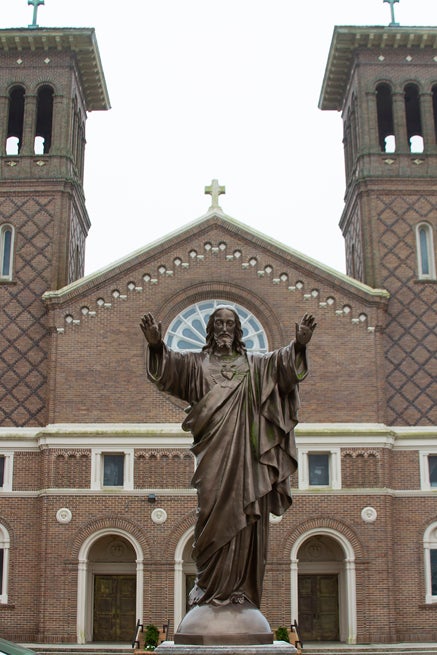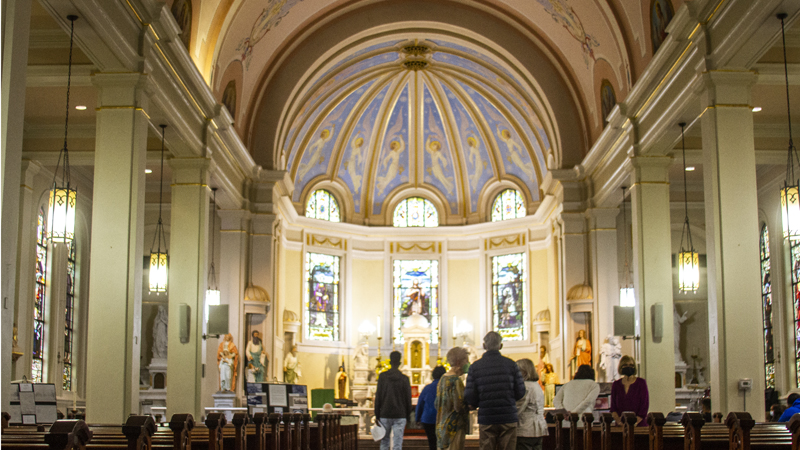St. John the Baptist Church commemorates 100 years
Published 12:09 am Wednesday, October 28, 2020

- District One Councilman Kurt Becnel, Sheriff Mike Tregre, historian Warren Caire and St. John the Baptist Parish President Jaclyn Hotard briefly took off their face coverings for a picture while celebrating the 100th anniversary of the St. John the Baptist Church building with church leaders.
|
Getting your Trinity Audio player ready...
|

The magnificent St. John the Baptist Church building at 2361 Highway 18 in Edgard is the third to stand on the original plot of land allocated in the 1700s.
EDGARD — Consecrated 100 years ago on Oct. 28, 1920, the St. John the Baptist Church in Edgard is an integral part of the region’s history.
Grand and worldly, the Roman Renaissance style architecture includes altars and communion rails made of white carrara marble imported from Italy and stained-glass windows made in Munich, Germany. Every ornate detail tells a story of the perseverance of generations of St. John the Baptist parishioners.
The first and second church buildings consecrated at 2361 Highway 18 were destroyed by floodwaters and fire, but the parish has continued to thrive with great spirit in the small community of Edgard. That much was evident Sunday, Oct. 25 as a full house of parishioners and elected officials gathered (social distancing style) to celebrate the 100th anniversary of the current church building.
Historian Warren Caire delivered an overview of the church’s history in between the sweet sounds of the gospel choir. During the ceremony, St. John the Baptist Parish President Jaclyn Hotard issued a proclamation to commemorate the grand milestone.
Father Robustiano Morgia remembers being told that Edgard is so quiet, “you can hear the sugarcane grow.” That has not stopped the church and parishioners from making bold impacts in the community.
“As we highlight the celebration, let’s remind ourselves that we are the people of today who will take care of this church and pass it on to the next generation,” Morgia said.
According to Caire, St. John the Baptist Church is the third oldest church parish in the Archdiocese of New Orleans, predated only by the St. Louis Cathedral (1718) and St. Charles Borromeo in Destrehan (1723).
While the current building was consecrated 100 years ago, the roots of the church trace back to the 1700s. In the early 1720s, a group of German settlers established a settlement in the area now known as Lucy. The area became widely known as La Cote des Allemands, or The German Coast. A small chapel was built to serve the new population.
In 1769, Acadians who settled in the area began a search for land to build a church. It was decided that wealthy bachelor Jacque DuBroc would donate four of his 12 arpents of land along the Mississippi River for the construction of a church and cemetery.
The governing Spanish authority at the time approved the request, and the land was expropriated on February 21, 1770. The first church, which stood in the same location as the modern St. John the Baptist Church, was constructed using hand-hewn Cypress trees. The new church carried the same name as the original chapel along the German Coast settlement. The first pastor was Spanish Capuchin Father Bernardo de Limpach.
The first church stood tall until it was swept away by floodwaters in 1821. Father Vito Modestus Mina, the parish priest at the time, orchestrated an effort to build a new church in the same location. Rather than using cypress trees, builders utilized handmade bricks for much of the structure. The second church, consecrated on March 17, 1822, also included a large wooden steeple that became a recognizable icon for travelers along the Mississippi River.
Just four years shy of its 100th anniversary, the second church building was destroyed in a vicious fire on March 19, 1918. Undeterred, Father Theopile Stenmans and the dedicated church community followed in the footsteps of their ancestors and began to rebuild. Just three days after the fire, $50,000 was subscribed for the new church at a meeting among parishioners.
The current church was built at a cost of $146,000, debt-free, and consecrated on Oct. 28, 1920. Adjusted for inflation, this would equate to approximately $2.52 million in expenses today.
The bells in the bell tower were recovered from the 1918 fire and serve as a link to former generations of the church parish.
The St. John the Baptist Church that greets parishioners and visitors today is reminiscent of a magnificent Roman Renaissance style. The grand structure is 143 feet long and 60 feet wide, with two towers reaching 89 feet into the sky. The interior ceiling is 55 feet high.

The interior of the St. John the Baptist Church in Edgard includes beautiful paintings, white carrara marble imported from Italy and stained-glass windows made in Germany.
St. John the Baptist Parish Sheriff Mike Tregre remembers what a big deal it was to ride the ferry and tour St. John the Baptist Church when he was a young boy attending St. Peter Catholic School. He hopes people will continue to tour the beautiful church and enjoy the architecture after the COVID-19 pandemic ends.
“Every time I walk through the doors of this church, I can’t help but admire the architecture and attention to detail that was put into this building,” Tregre said. “It gives you a feeling of strength, confidence and motivation to be able to take the same attention to detail in our lives as Christians.”
As sheriff, Tregre traditionally presents St. John Parish residents with a commemorative blanket when they turn 100 years old.
“I’m not sure a blanket will suffice on this occasion,” Tregre said. “So, what do you give a church that has been a special place of worship for countless generations of baptisms, weddings, funerals and a Mass celebration for newly elected parish officials? You give it prayers to continue to fill with good people who will continue to love and cherish and respect this strong place in the history of St. John the Baptist Parish.”




